

Egyptian Fractions at Math Cats. Education in Ancient Greece - Fun Facts. Greek Education The Greeks loved to learn!

They believed that learning was one of the best ways you could spend your time. How did the ancient Greeks write numbers? Grandmother's Legacy: Space Invaders: a group project. Spencer Diamond here.
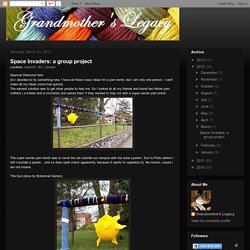
So I decided to try something new. I have all these crazy ideas for a yarn bomb, but I am only one person. I can't make all my ideas come true quickly. The easiest solution was to get other people to help me. So I looked at all my friends and found two fellow yarn crafters ( a knitter and a crocheter) and asked them if they wanted to help me with a super secret yarn bomb. The super secret yarn bomb was to cover the rail outside our campus with the solar system.
The Sun (done by Botanical Garden) Mercury (done by Botanical Garden) Venus (done by Botanical Garden) Earth (done by Botanical Garden) Sorry the photo quality is poor... Yarn bombing. KNITS FOR LIFE. We make, install, maintain, and remove the vast majority of our work and almost always get permission to install.

We have never “gotten in trouble” or been asked to remove a new yarnbomb. Our yarnbombs do not damage flora and fauna. Yarnbombing is not a waste of time. Download hi-res images of our work from these Flickr sets or contact us. All images are approved for free cultural works (CC BY 2.0). To commission new work, contact us. View our portfolio here. String art by Lorna Watt. 30 Creative Examples of Yarn Bombing. Caesar, the Anzac dog. Caesar, A Company, 4 Battalion, New Zealand Rifle Brigade Caesar the bulldog, wearing his official collar, led the grand parade down Auckland's Queen Street before the Rifle Brigade left New Zealand for the war.

He was a trained Red Cross dog and helped rescue wounded troops during the Battle of the Somme in 1916. Dogs were especially useful for helping stretcher-bearers find wounded soldiers in no man's land at night. Caesar was killed in action. His collar is now held at the Auckland War Memorial Museum. First World War mascots - Military mascots. Caesar, A Company, 4 Battalion, New Zealand Rifle Brigade Caesar was a trained Red Cross bulldog that, before being killed in action, helped rescue wounded troops during the Battle of the Somme in 1916.
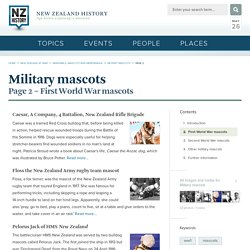
Dogs were especially useful for helping stretcher-bearers find wounded soldiers in no man's land at night. Garnisonen i Sør Varanger dog. Belgian Shepherd Malinois on top of tank. Dogs in warfare. Dogs in warfare have a long history starting in ancient times.
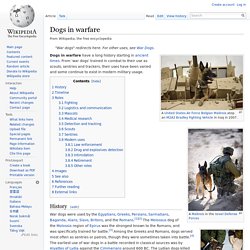
From 'war dogs' trained in combat to their use as scouts, sentries and trackers, their uses have been varied and some continue to exist in modern military usage. History[edit] During the Late Antiquity, Attila the Hun used giant Molosser dogs in his campaigns.[1] Gifts of war dog breeding stock between European royalty were seen as suitable tokens for exchange throughout the Middle Ages. Other civilizations used armored dogs to defend caravans or attack enemies. The Spanish conquistadors used armored dogs that had been trained to kill natives.[6] Animals and war. Millions of animals were relied upon by all sides in World War One.
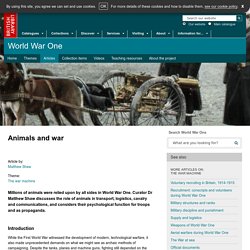
Curator Dr Matthew Shaw discusses the role of animals in transport, logistics, cavalry and communications, and considers their psychological function for troops and as propaganda. Introduction While the First World War witnessed the development of modern, technological warfare, it also made unprecedented demands on what we might see as archaic methods of campaigning. Despite the tanks, planes and machine guns, fighting still depended on the physical and emotional suffering and sacrifice of men, who also had to contend with mud, sand, water, disease and often brutal weather.
Dogs in warfare - WWI: Animals in War - Stills Galleries. Dogs' WW1 jobs uncovered in records. Image copyright PA Up to 20,000 dogs were trained for front-line duties during World War One, newly uncovered records have shown.
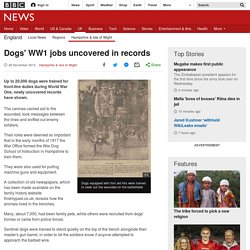
The canines carried aid to the wounded, took messages between the lines and sniffed out enemy soldiers. Their roles were deemed so important that in the early months of 1917 the War Office formed the War Dog School of Instruction in Hampshire to train them. The 9 million unsung heroes of WW1: Dogs, horses and carrier pigeons made victory possible. Trapped behind enemy lines during the First World War, the few surviving soldiers of the 77th Infantry Division came under fire from both sides.

As German bullets strafed through the Argonne Forest in north-east France and picked them off one by one, they came under heavy shellfire from their own lines too. With less than 200 men from a 500-strong unit still alive, three messengers were sent on a perilous last-ditch mission to let HQ known their position. Dogs in World War One. Dogs had a vital part to play in World War One as the complexes of trenches spread throughout the Western Front.

It is estimated that by 1918, Germany had employed 30,000 dogs, Britain, France and Belgian over 20,000 and Italy 3000. WW100 New Zealand.